5 Day Trips From Granada That You Don’t Want to Miss

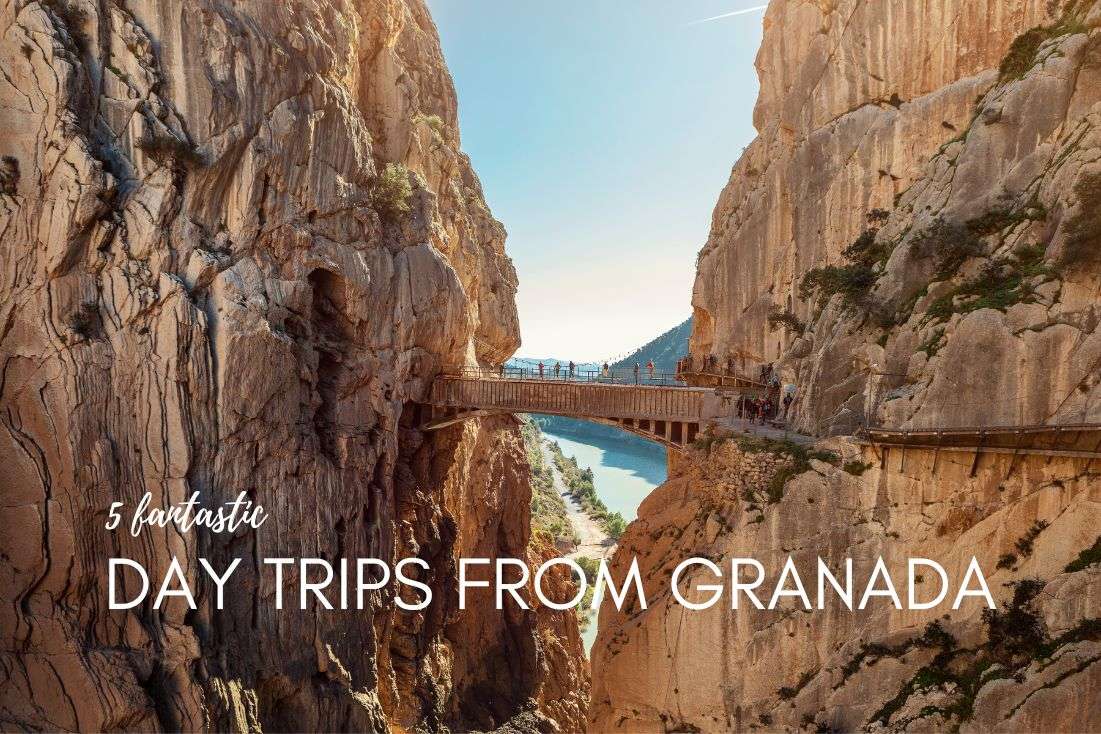
You’ve toured the world-class Alhambra Palace and eaten free tapas all over the place, now what? It’s time to explore Granada’s surroundings on some fantastic day trips!
Granada is a pleasant city, even if there isn’t tons to do. So go ahead and book your hotel for a few extra nights and use it as a base while venturing beyond the city limits.
Tip: You can read more on tapas culture in another post if you are surprised by the mention of free tapas in Granada. There are recommendations on the best tapas restaurants in Spain in there, too.
You might also be interested in reading:
- Andalusia Itinerary: Southern Spain in 10 Days
- Barcelona Itinerary: 5 days in Gaudí’s Metropole (with day trips)
- All You Need to Know about Spanish Tapas (+Restaurant Tips)
- The 10 Best Museums in Spain’s Top Cities
- The 16 Most Beautiful Beaches in Spain
1. World capital of olive oil: Jaén
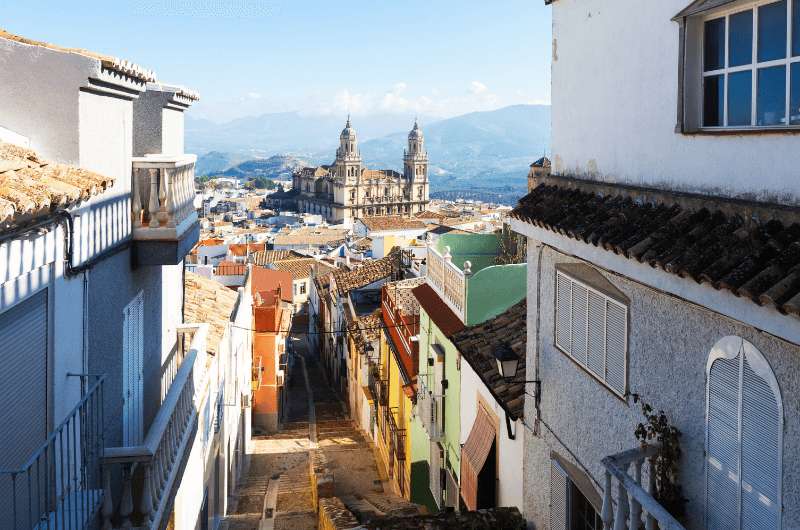
Looking through the streets of Jaén towards the Cathedral
With a population of about 115,000, Jaén is a decently-sized city, about half the size of Granada. It isn’t on the main tourist trail, which is ironically why it makes all the top day trips lists. It doesn’t hold up as a destination on its own, but for a day exploring away from the main drag, why not.
- Distance from Granada: 90 km/55 miles, a 1-hour drive
- Main attractions: olive oil, Holy Face, fortress
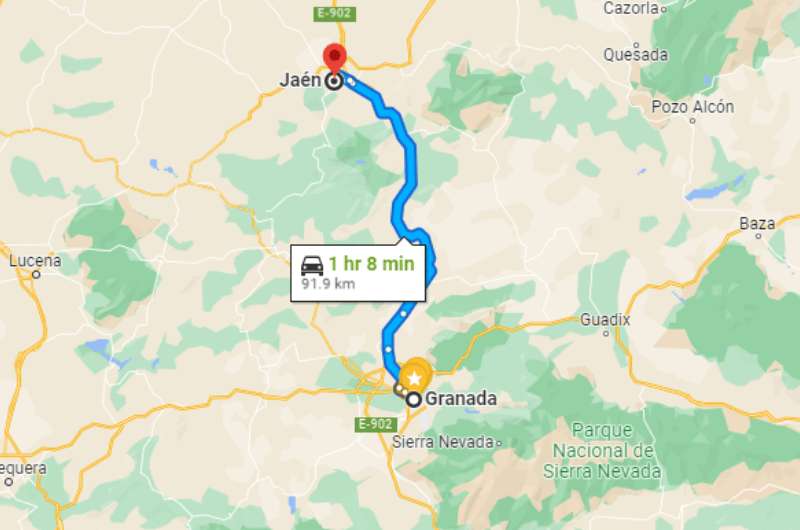
A little over an hour, and you're in Jaen!
Olive oil of Jaén
One third of the world’s olives come from Andalusia, and half of Andalusia’s olives come from—you guessed it—Jaén! The province of Jaén has some 60 million olive trees and you will see them literally everywhere that isn’t a national park (20% of the province’s land is protected in the national park system). It isn’t called the world capital of olive oil for nothing!
The largest olive oil factory in the world, the Cooperativa Nuestra Señora del Pilar, is also located in the province. Look out for the brand Cazorliva that is made there. Most olive oil will be made out of the Picual variety of olives, which give the oil a distinct grassy flavor and atypical green color.
Souvenirs, anyone? You will find olive oil shops all over Jaén. The factory mentioned above has its own shop on site, though it is a ways out of town. For something in the city, head to The Aceitera Jaenera, a smallish shop where you will be treated like a king by the knowledgeable owners and will leave with way more “liquid gold” than you were planning on buying.
Jaén’s Cathedral
Jaén’s cathedral, the Nuestra Señora de la Asunción Cathedral, is considered one of the most important structures of Renaissance architecture in all of Andalusia. You can’t miss it, it is a massive building jutting way above the surrounding buildings of the city. The choir is one of the largest in Spain.
The Holy Face
The cathedral is home to the Holy Face, a cloth that was used by Saint Veronica to wipe Jesus’ face as he carried the cross. It is a prized religious artifact.
The Holy Face in Jaén is actually supposed to be a replica of the original, the Veil of Veronica, though nobody even knows if the original is an original, and there isn’t even consensus on which of the clothes displayed in various churches across Europe is the real one. If this is something that intrigues you, read our post on visiting the Turin Shroud—another clothe with a mysterious Jesus picture on it.
The Holy Face of Jaén has its own chapel. On Friday mornings, it is possible to stand in line and take turns kissing the glass case that houses it. No worries, the priest wipes it down after each visitor! Really, it’s fine.
The Santa Catalina Fortress
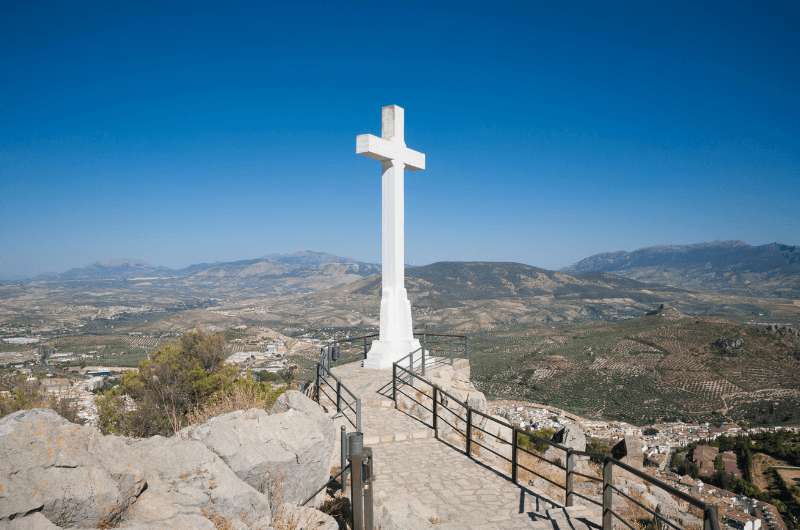
The cross at the Santa Catalina Fortress
Santa Catalina Fortress sits on hill above Jaén. The views from it are stunning—you get the city, the olive groves and the mountains. I’ve heard the sunrise is worth getting up early for, but I’ll leave that up to you early birds to find out.
You can walk up to Santa Catalina in about 45 minutes, but it is steep. Otherwise, a 10 minute drive takes you there with no sweat.
Make sure to take the walkway to the monumental cross, where the views are the best.
You can also stay at the Parador de Jaén, a hotel in a reconstructed part of the fortress. The views are fantastic and you really get to enjoy the architecture in the interiors.
2. Nerja’s beaches
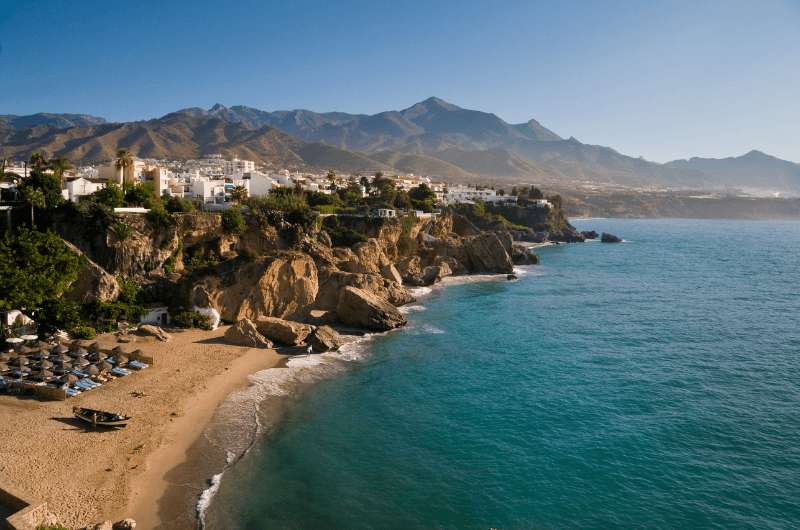
The Nerja’s coast Is amazing
Once you’ve been in Granada for a couple of days, you might start missing the coast. The smell of the air, the vacation vibes… Luckily, Nerja is only a short drive south. With dreamy Frigiliana village just a short hop away, you combine beaches and villages into an easy day trip from Granada.
- Distance from Granada: 95 km/60 miles, a 1-hour drive
- Main attractions: Frigiliana village, Balcón de Europa, beaches
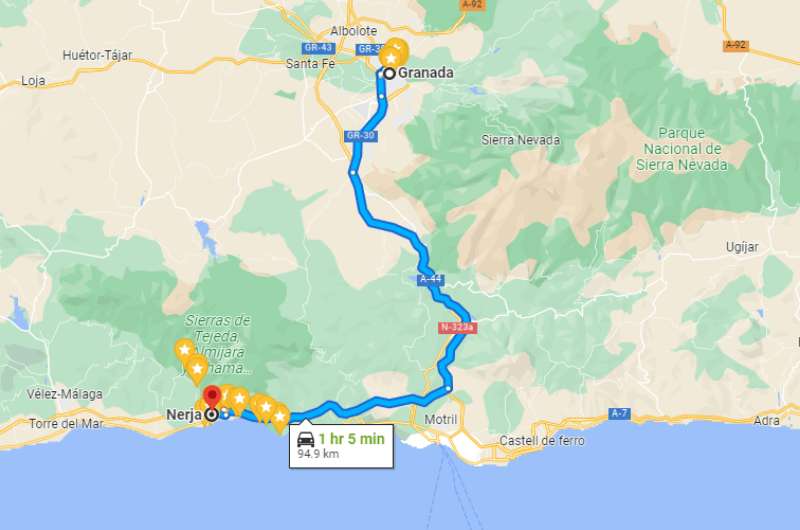
The beautiful Nerja’s coastline is also not too far from Granada!
Balcón de Europa
The Balcón de Europa is the reason most people come to Nerja. It’s a busy plaza on the tip of a rock jutting out into the sea with many restaurants, performances and just life in general, especially during the evenings. If you’re looking to eat well, it is hard to sort through the myriads of tourist trap restaurants. One standout is El Lagar Restaurant. We’ve written about it and another top choice, Oliva Restaurant, in our overview of the best restaurants in Spain.
The Balcón of course has a good coastal view as well. I’d recommend that you come here for the atmosphere and a night out, but there are better viewpoints in the area, like Vigía De Cerro Gordo or the Maro Tower Viewpoint.
Frigiliana
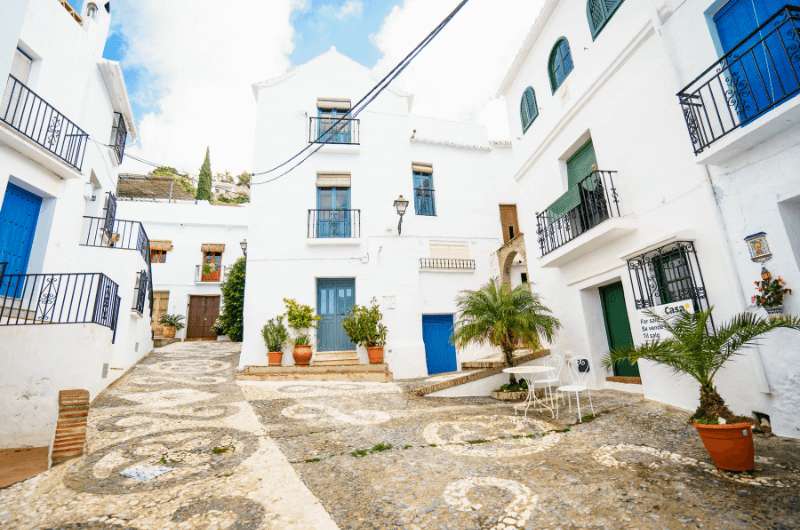
The splendid whitewashed houses of Frigiliana village
Frigiliana village is located in the mountains behind Nerja. Even though it’s only 6 km (4 miles) away, it’s like a hidden Spanish dreamland. The houses are white with flat brown roofs, the streets are narrow with tiles or cobblestone on the ground. Add hints of blues and purples, potted plants outside every door and you have an Instagram shot!
Since Frigiliana is stacked up on a slope, you get incredible views of the coast from just about every tidy, flower-lined street. Plus, the best hikes start right in the village. More on those and other attractions in our post about Nerja.
About a third of the inhabitants of Frigiliana are expats, so you’re in a tiny little Spanish village, but you get a strangely cosmopolitan vibe. The expats also like to eat and drink well, so there are many good quality restaurants in Frigiliana.
Tip: Base yourself in Frigiliana if you want to turn this day trip into an overnighter!
Best beaches in Nerja
El Salón and Carabeillo will be the best beaches directly in Nerja town. Playa el Salon, which is right next to the Balcón, usually isn’t as crowded as the other beaches right in the main tourist area. The few extra steps down a winding path that you need to take in order to get to it seem to deter a lot of the lazier visitors.
Carabeillo is a smaller cove beach at the west end of the main city beach, Playa Burriana. If you aren’t fond of banana floats and beach vendors but still want to be close to all the amenities, Carabeillo is a good spot.
Our top tips for day trips from Granada:
- Always rent a car. Getting to some of these places without one is impossible.
- If you are planning on walking the paths of Caminito del Rey, book you visit months in advance.
- Don’t stop at the beginning of Alpujarra, push through the winding roads all the way to Capileira.
For a more serene, natural beach, head out east beyond Maro. Playa de las Alberquillas and Cala del Cañuelo are some of the most beautiful natural beaches that also have great snorkeling. The beach options are unlimited, we recommend getting your car, taking a drive along the coast and seeing what treasures you find.
If you’re looking for options for a beach vacation, read more on the best beaches in Spain in another post.
3. Montefrío’s award-winning views
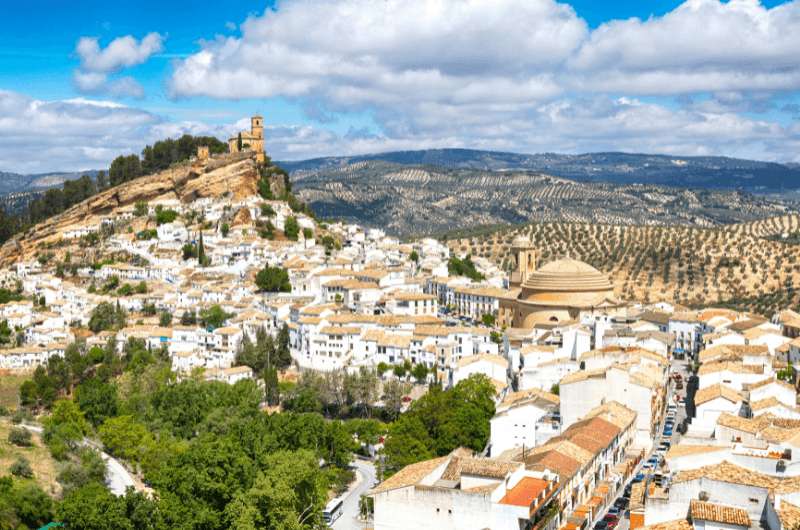
Amazing Montefrío!
Not even a decade ago, Montefrío was just a random village in the middle of nowhere that nobody knew about, just like the dozens of others sprinkled around Granada. But it keeps forcing itself into the forefront by winning international awards!
- Distance from Granada: 50 km/32 miles, a 50-minute drive
- Main attractions: award-winning views, cheese
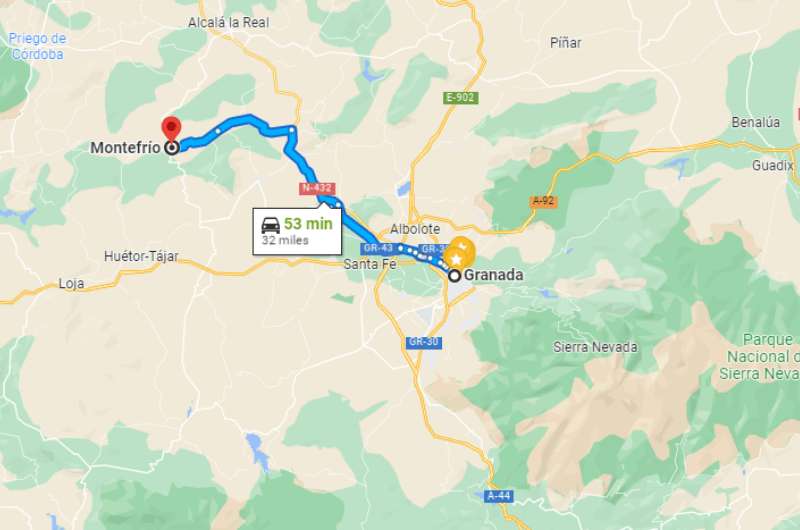
Montefrío is a daytrip you can’t skip while you’re staying in Granada!
In 2015, it was named by National Geographic as one of the ten villages with the best views in the world, and it shot into instant stardom. Granted, at closer inspection, the list seems to focus on villages only in southern Europe, but unless you know that little detail, it is an extremely impressive feat!
Still, being a village of white houses with sand colored rooftops, surrounded by endless olive groves, rolling hills and guarded by a castle perched atop a cliff, makes it pretty easy to understand what National Geographic saw.
Queso Montefrieño
Other than that, you may or may not be drawn to Montefrío thanks to another accolade it got in 2017. Its cheese won amongst 3,000 other cheeses from the entire world in the goat cheese category, and scored third place for its goat and cow’s milk soft cheese.
The cheese factory is located on Avenida Miguel Hernández and has a shop where you can buy all kinds of cheeses directly from the source.
National Geographic Viewpoint
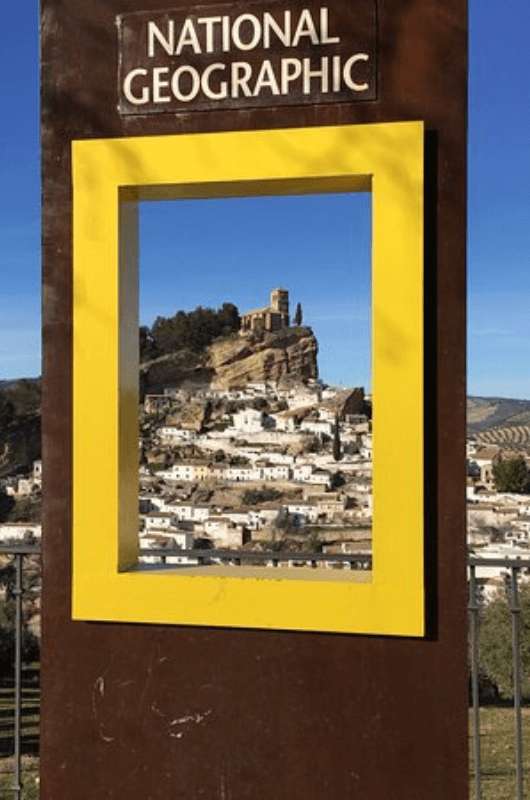
The National Geographic Viewpoint on Montefrío
To judge the view that won Montefrío its “best view” title, head up to the National Geographic viewpoint (Mirador de National Geographic) to the south of the village. There’s nowhere to park and will probably be surprised that the viewpoint is basically right on the road, but once you manage to leave your car somewhere and walk to it, you’ll see the magic. There’s even an awful National Geographic photo frame structure waiting for you to stand in it for your pic.
This is where you’ll get the view of the whole village with the Castillo on the cliff to the right, with the peculiarly round church, Iglesia de la Encarnación, poking up from the village’s center. It is the only round church in Spain and was modelled after the Pantheon in Rome.
Castillo de La Villa
After the mandatory NatGeo viewpoint, you will want to take the 20-minute steep walk up that cliff to a church that was once a castle protecting the village below it. You’ll see the signs pointing you towards the Castillo in town. You can buy your €2 ticket at the tourist office and then visit the small exposition inside the church telling you about the village’s history.
4. Alpujarras
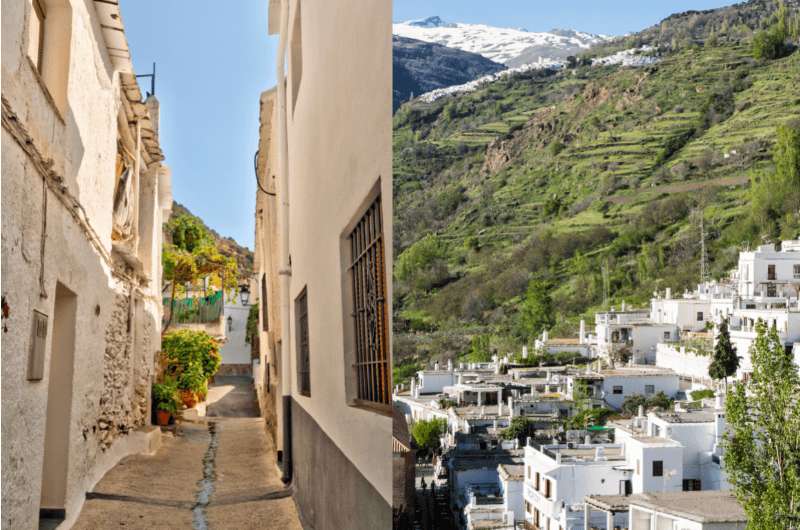
The highest of the three villages of Poqueira Valley
Granada sits right next to the Sierra Nevada National Park. And a whole bunch of little villages that look just like they did ages ago sit on the northern slopes of the Sierra Nevada. The area is called Alpujarras and is a top day trip from Granada.
- Distance from Granada: 68 km/42 miles, a 1-hour 15 minute drive to Poquiera Valley (but just 47 km (30 miles), a 45-minute drive to Lanjarón, the first village of the Alpujarras area
- Main attractions: Berber villages and views of the Sierra Nevada Mountains
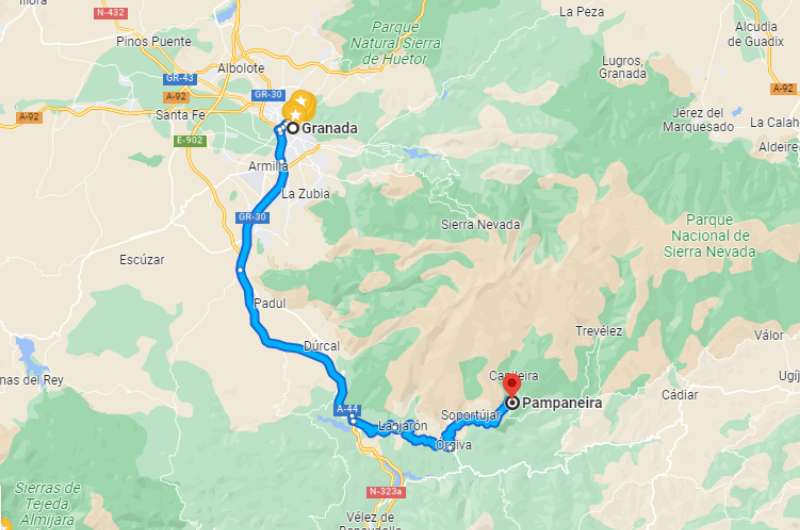
Alpujarras, we’re coming!
Way back in the day the Alpujarras area was difficult to reach. It was the Berbers—an ethnic group indigenous to North Africa—who inhabited the slopes after the Moorish invasion of 711 CE. They figured out a way to direct the water from the melting snow from the mountains into irrigations channels that allowed settlement.
That water is also what kept the hillsides fertile and green all year round, making it possible to grow food, hence seeming like a good place to hide from the invaders. It’s also why you will constantly hear water flowing when you visit.
Even though the Moors eventually managed to conquer these hills, the fact that the 50 or so villages stayed hard to reach for centuries is why they have retained their original charm and Berber architecture to this day: small, two-story houses with flat roofs and round chimneys, whitewashed, and built one right next to the other with narrow alleys in between.
The views of the snow-capped peaks and surrounding nature don’t hurt either. When you’re driving up towards the villages, it’s like the white houses are oozing out of the mountain, spilling down the slope. Time has stopped in this part of Spain, and it’s a treat to be able to experience the tranquility.
All of the villages offer handicraft shops, restaurants, and most also have accommodation. There are many hiking paths that start from a number of the most popular villages, too.
The Sierra Nevada is home to Spain’s highest mountain, Mulhacen, at 3,479 m (11,400 feet). And the Alpajurras are home to Spain’s highest village, Trevélez, at 1,476 m (4,800 feet).
Poqueira Valley
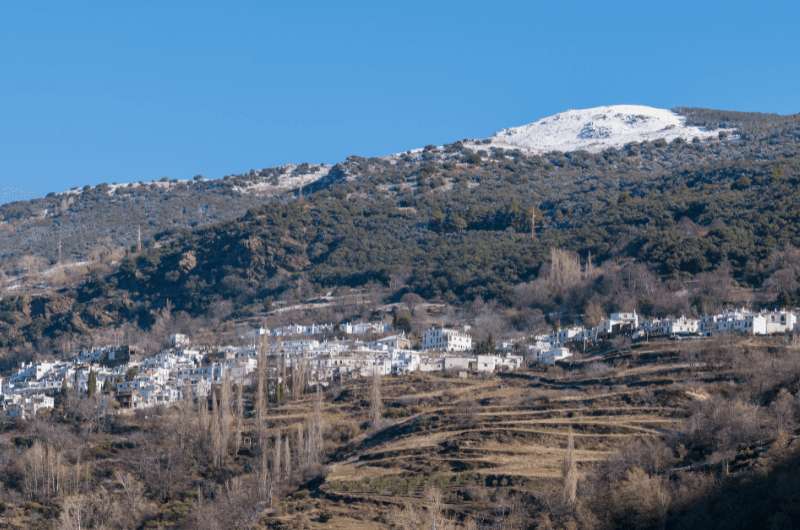
Driving up to Bubión
Within Poqueira Valley sit some of the most picturesque of all the villages. Pampaneira is at the bottom and boasts many little shops where you can buy things like colorful, hand-woven woolen rugs.
Bubión is the middle village and has a large church in the middle. It is also a great base for hikes, as it’s on the GR7 long-distance footpath.
Capileira is the highest of the three and if you wander to its lower streets, you’ll see some non-remodeled houses there. A real piece of history! Of course, being on top of the hillside means you get great views of the gorge and the peak of Veleta. If you wander up the dirt road on the northern end of the village, you’ll get some pretty cool views of the village and the mountains (look for “mirador Sierra Nevada Capileira” in Google Maps).
Capileira also has the widest selection of accommodation, some of which is very cute and even decently comfortable and has the village’s fantastic views available straight from the patios.
5. Have an adventure at Caminito del Rey and El Torcal
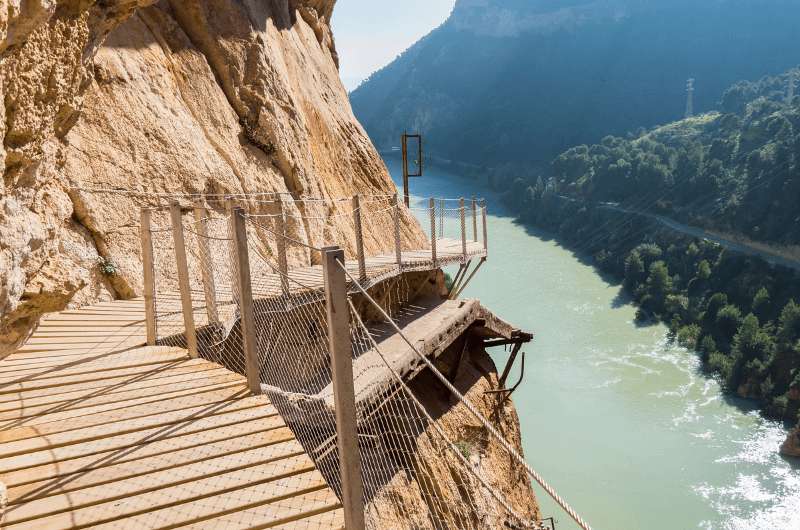
The new, comfy walkway suspended above the old, rickety one at Caminito del Rey
This area turned out to be one of our absolute favorite spots in Andalusia (check out the post for more details on this destination)! The best nature spot for sure, Caminito del Rey is a combination of nature and adrenalin, and El Torcal is a nature reserve with a karst landscape. It is a bit further out from Granada, but definitely worth a trip. If you’re also planning on staying in Malaga, make Caminito del Rey a day trip from there.
- Distance from Granada: 140 km/85 miles, a 1 hour 45 minute drive
- Main attractions: walkways suspended on the rock face, karst landscape
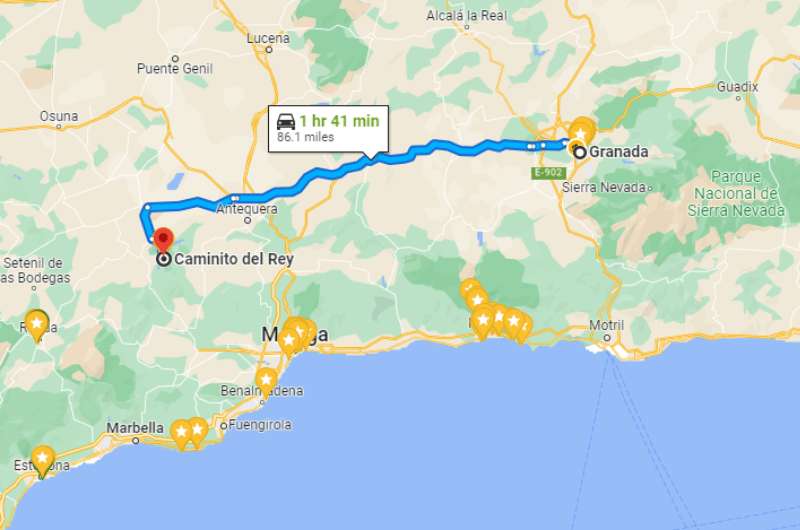
Time for some adrenaline at Caminito del Rey
Caminito del Rey
At Caminito del Rey, you’ll be going on a series of walkways bolted into the rock face 330 feet (100 m) above the gorge floor! The views are incredible and the fun is nonstop. And sometimes it’s scary and that’s also fun if you ask me!
Caminito del Rey’s full length over 7.5 km (4.5 miles), but the stretch with the boardwalks is understandably the most popular, at about 3 km (1.8 miles) and takes about 2.5 hours to walk through.
Be sure to make a booking as far in advance as you can, and I mean months. Also beware that the entrance is a 20-minute walk from the parking lot and you have to get to the start before your reserved time slot. The parking lot itself can be tricky to find (type Aparcamiento Caminito del Rey into Google maps, not just Caminito del Rey). You get a shuttle from the end back to the parking lot at the end.
El Torcal
El Torcal is a nature reserve in the Sierra del Torcal mountain range. It’s a karst landscape that is pretty impressive unless you are from a country with many karst landscapes, in which case it won’t blow your mind. Still a nice trip though and those of you without much karst experience might even feel like you’ve landed on another planet.
There are three main hiking routes here and they are all easy. There isn’t much elevation and unless it is muddy, the terrain won’t give you much trouble, aside from a rock here and a step there. The green route will only take you 45 minutes, so you can get some karst landscape in even if you’re short on time. The yellow and orange routes take 2 and 4 hours respectively.
If you have no time or desire to walk, just head over to the visitor’s center and take in the views from the viewpoint just past it. There is a restaurant there too if you want to get a snack before driving onwards.
Tip: Alternatively, make Caminito del Rey and El Torcal a stop on your trip after leaving Granada. Then you can keep going a little less than an hour further (after you’ve finished your hikes) to the cliff top village of Ronda and book a hotel there for the night. Check out the New Bridge that straddles the deep gorge and tour the oldest bullring in the world.
Where to next?
No matter how much time you have in Andalusia, there is always so much more to see. Your next stop could be Sevilla, with its fantastic Alcazar palace and impressive Plaza de España. Or, head out of the country to the little tip of the Iberian Peninsula that is oh so close to Morocco, Gibraltar.
This post may contain affiliate links. We earn a small commission if you make bookings through my links, at no additional cost to you. This helps us keep this blog free, thank you!


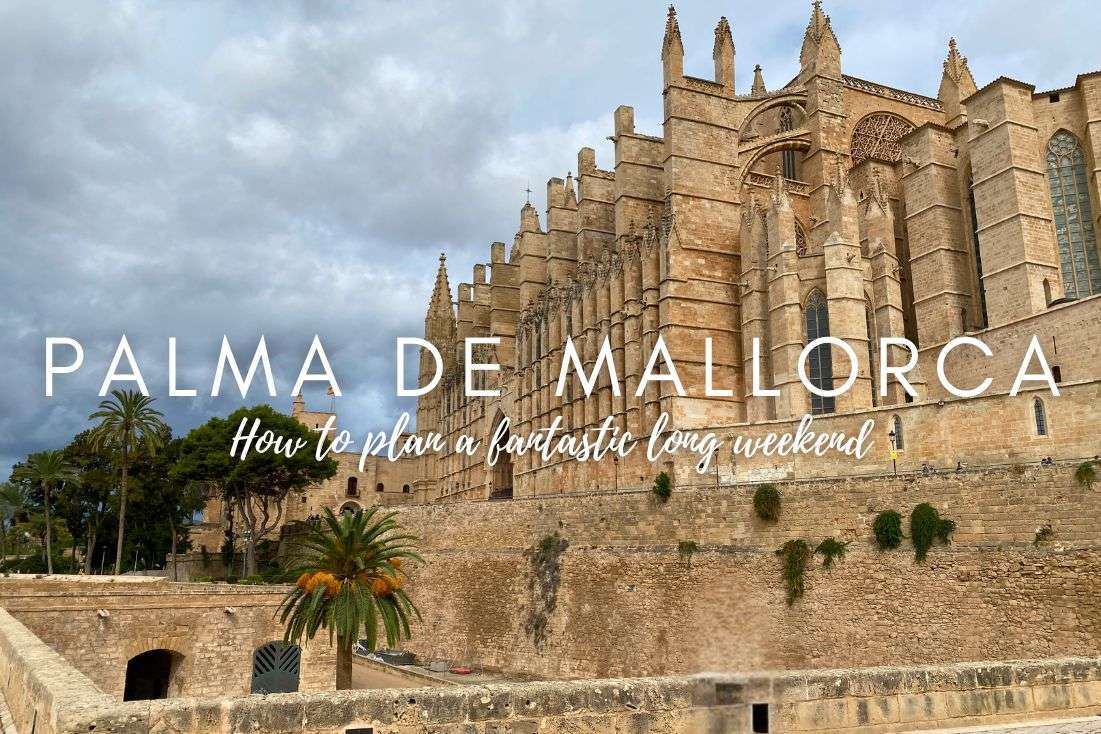
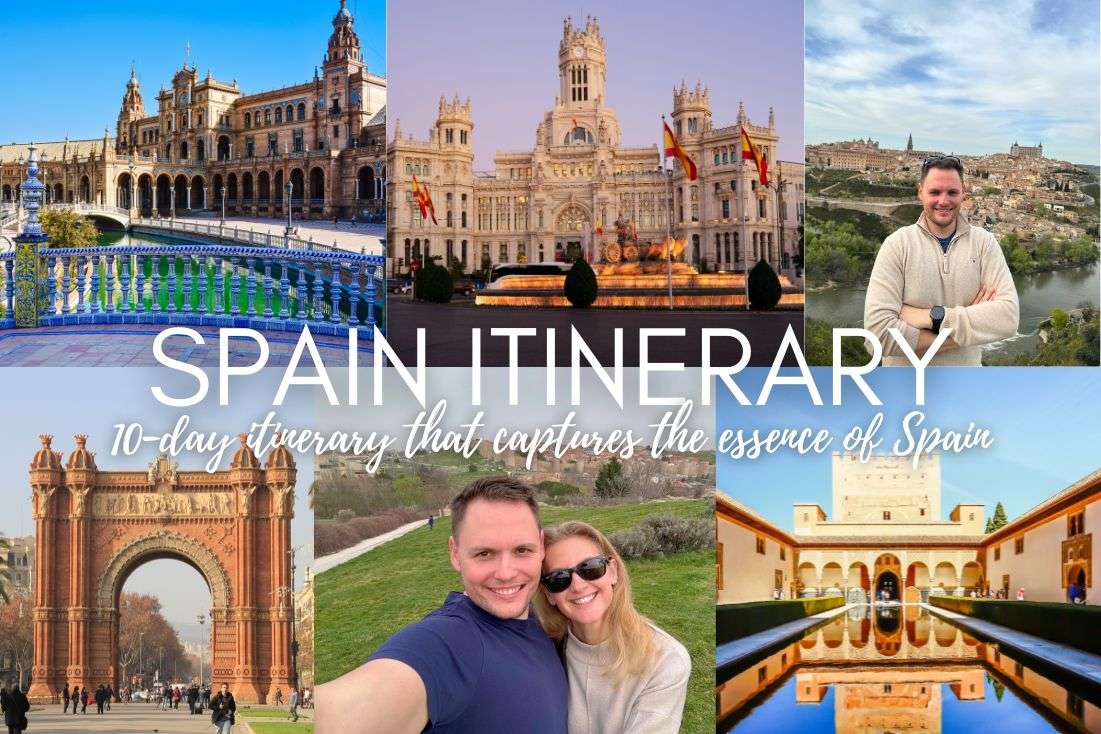
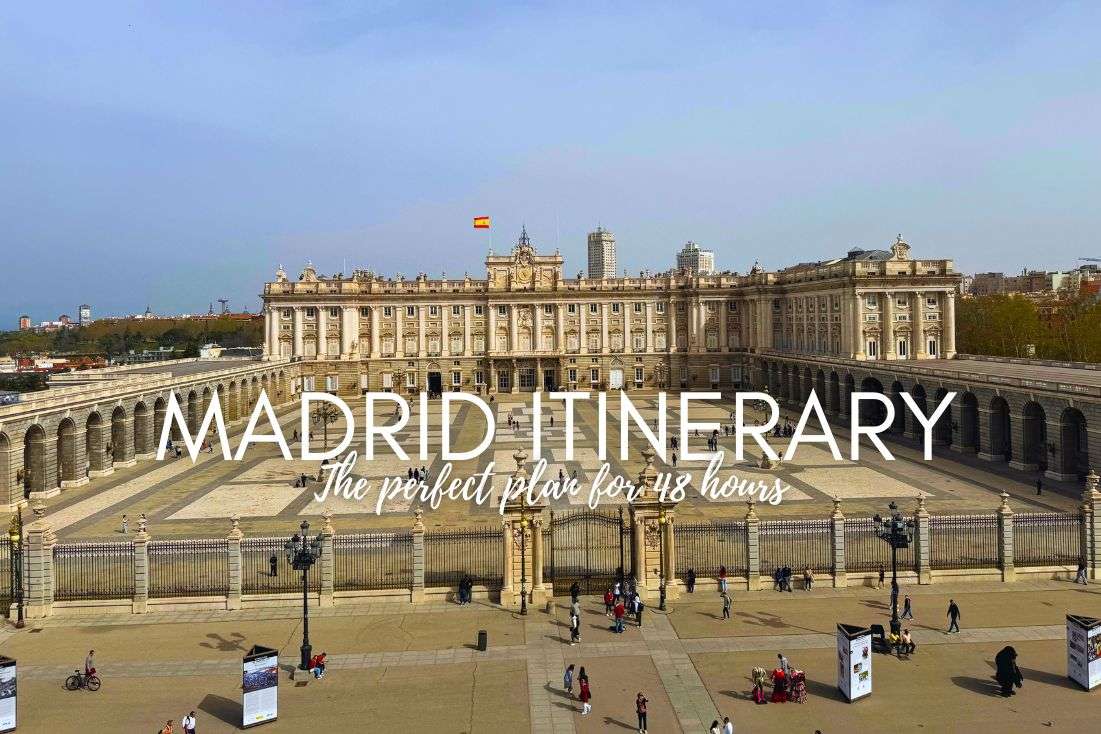





Comments | Thoughts? Give us a shout!